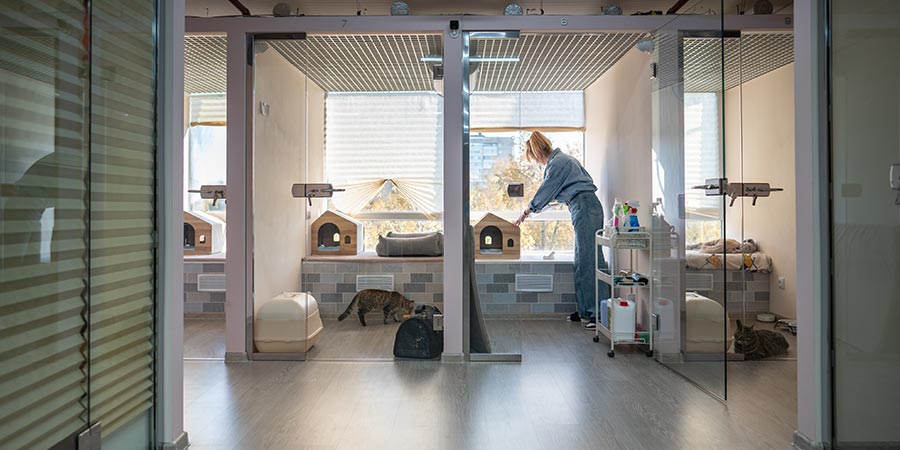
Animal shelters are emotional spaces—not just for the abandoned or rescued pets who reside there, but for the humans who work tirelessly to care for them. These spaces witness trauma, joy, reunion, healing, and heartbreak. Designing them, therefore, isn’t just a functional exercise. It’s about creating environments that are safe, efficient, and deeply humane.
While there’s no shortage of checklists and code-compliance guidelines out there, designing a truly smart animal shelter demands something more: empathy-driven architecture that aligns with USA-based animal welfare standards and local needs.
Here are five key considerations that go beyond the basics—and into what really matters.
1. Behavior-First Design: Because Every Bark (or Meow) Has a Backstory
In many shelters, animals arrive scared, stressed, or traumatized. A space that looks clean and organized to us may feel chaotic and threatening to them. That’s why behavior-informed layouts are key.
For instance, housing dogs in rows of kennels facing each other—a legacy design feature—is now considered outdated. This setup often triggers anxiety, which results in excessive barking and behavioral issues. Instead, U-shaped kennel arrangements, visual barriers between runs, and indirect exposure to foot traffic help keep stress levels down.
Case in Point:
At the PAWS Chicago Adoption Center, dogs are accommodated in individual living quarters with glass doors, and pacifying acoustics are integrated into the walls. Volunteers report quicker socialization and fewer incidents of aggressive behavior.
“We care for each animal like someone with trauma-informed design principles. It makes a measurable difference.”
– Katherine Nguyen, Lead Architectural Designer, Uppteam
2. Zoning with Purpose: Because Chaos Isn’t Cute
A smart shelter isn’t just animal-friendly—it’s also staff-friendly. Zoning plays a vital role in ensuring that operations remain smooth, safe, and scalable.
There needs to be a clear separation of:
- Public vs. restricted zones
- Quarantine/intake vs. adoption-ready areas
- Surgical/veterinary spaces vs. general housing
Additionally, smart zoning reduces disease transmission, improves cleaning efficiency, and supports better animal flow from intake to adoption.
Example:
In California, a recent municipal shelter upgrade included one-way traffic flows for animals from intake to adoption, inspired by hospital workflow models. The result? Intake bottlenecks decreased by 40%.
“In one of our recent U.S. shelter projects, we worked closely with behaviorists and staff to define zones not just by function but by emotional impact on animals. That’s how design earns its place.”
– Riley Thomas, Civil & Structural Team Lead, Uppteam
3. Acoustics Matter More Than You Think
Shelters are loud. Barking dogs, clanging food bowls, and echoing hallways can create a cacophony that’s not just annoying—it’s detrimental to animal health.
Stress caused by noise can delay recovery, lead to aggression, and increase staff burnout. Smart designs include:
- Acoustic ceiling panels
- Rubber flooring
- Kennel partitions that absorb sound
- HVAC systems that reduce mechanical hum
Quick Stat:
According to the Humane Society of the United States, shelters that implemented acoustic-dampening materials saw a 23% drop in anxiety-related incidents among animals.
One Memorable Insight:
“We once worked on a facility in Texas where the dogs stopped barking nonstop after we introduced just two acoustic retrofits. The staff actually teared up. That’s the power of good design.”
– Harshal Doshi, Division Leader, Uppteam
4. Flexibility for the Future: Because Needs Change
Shelters often begin with one vision but quickly outgrow it. That’s why modularity and adaptability are so important.
Design with:
- Mobile partition walls for reconfigurable rooms
- Convertible spaces (e.g., indoor/outdoor runs)
- Scalable utility access points for future veterinary areas or isolation wards
Also, energy efficiency and sustainability aren’t afterthoughts anymore. Many cities in the U.S. are now encouraging LEED-certified designs or at least incorporating green building materials.
A Real Challenge:
“We designed a shelter in Florida where hurricanes are a serious threat. Our structural team ensured animal safety through elevated kennel flooring, reinforced roofing, and on-site storm shelters—built smart, not just code-compliant.”
– Brijesh Dalsaniya, Division Leader, Uppteam
5. Community Integration: Because Shelters Shouldn’t Feel Hidden
Finally, great shelters don’t isolate themselves—they invite the community in. That means creating spaces that:
- Allow for meet-and-greet zones with adoptable animals
- Host training or educational workshops
- Include child-friendly areas for school visits or adoption drives
Transparency builds trust. Visibility leads to higher adoption rates. And people are more likely to support a shelter that feels accessible and welcoming.
Design Tip:
Use large windows, open lobbies, and informative signage to make the space feel less institutional and more inclusive.
“We always say a shelter that looks like a prison is designed for storage. A shelter that looks like a home? That’s designed for healing.”
– Swati Singh, Division Leader, Uppteam
Wrapping Up: Designing with Heart and Science
Designing an animal shelter is one of those rare projects where architecture intersects directly with empathy. Each square foot affects the welfare of those without a voice—animals that depend on design choices to experience safety, comfort, and care.
At Uppteam, our AEC experts have collaborated on several U.S.-based animal shelter design projects—each one uniquely guided by the needs of its community, its animals, and its caretakers. Whether it’s engineering climate-resilient shelters in hurricane-prone regions or optimizing layouts for quicker adoptions, our approach blends technical know-how with heartfelt purpose.
We believe good design isn’t just what you build—it’s what you change. And sometimes, what you change is the life of a scared kitten, a rescued pup, or the family that finally takes them home.


















